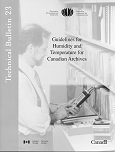There is no single relative humidity range that is ideal for all museum objects. Recent work by the Rochester Institute of Technology’s Image Permanence Institute shows that lowering the relative humidity (RH) and temperature (T) will greatly increase the life of plastics and other organic materials. Relative humidity (RH) should not fluctuate rapidly. For mixed collections, a non-fluctuating relative humidity above 25% and below 65% is recommended. Many museums have set their relative humidity at 45% and gallery temperatures between 65 and 68 degrees Fahrenheit. Lowering the temperature greatly increases the longevity of collections. However, lower temperatures are hard on visitors to the museum.
Relative Humidity
Fluctuating relative humidity (RH) causes stress on materials. Rapid humidity fluctuation damages a wider range of museum objects than does temperature change. A change in RH causes dimensional alteration in hygroscopic materials (for example, wood, ivory, skin, and other organic materials), resulting in warping, splitting, and delamination of sensitive materials. Seasonal slow drifts are less harmful to structures and objects than abrupt changes. High RH (above 65%) can cause mold growth and metal corrosion. Low RH (below 25%) can cause embrittlement of hygroscopic materials such as leather and paper.
However, if you are in a wet or dry climate, it may not be possible to maintain the ideal RH level. Try to set your relative humidity level so that it is stable somewhere between 25% and 65%. Above 65% mold will grow, more rapidly as the RH rises. Below 25%, the materials may lose structurally important water. If you cannot achieve even these levels, achieve a reasonable level that does not fluctuate. If this level is above 65%, make sure you have good air circulation and regular inspections for mold growth.
Temperature
Temperature is the major factor in the speed at which "natural aging" occurs. Materials last longer at cooler temperatures. A rapid change in temperature, if the relative humidity is constant, may have damaging effects on stressed metals, stone, films, plastics or wax, materials from which many modern collections are made. High temperatures increase deterioration reaction rates and melt heat-susceptible materials. Store inherently unstable materials, like plastics and rubber, in cool temperatures and lower RH levels to decrease the rate at which they naturally deteriorate. Waxes and plastics are damaged by freezing, so should be kept cool, but not frozen. The Image Permanence Institute (not on the Internet yet) has developed resources for determining the longevity of film materials at specific temperatures and relative humidities.
|
MS104: An Introduction to Collections Preservation Course Description & Info Instructors: Gretchen Anderson & Helen Alten Student Login Price: $475 Jan 6 – Jan 31, 2014 [Learn More] Apr 7 – May 2, 2014 [Learn More] Jul 7 – Aug 1, 2014 [Learn More]
| |
|
MS211: Preservation Environments Course Description & Info Instructor: Ernest A. Conrad Student Login Price: $495 Nov 4 – Dec 6, 2013 [Learn More] July 7 – Aug 8, 2014 [Learn More] Nov 3 – Dec 5, 2014 [Learn More]
|
Books and products we recommend:
 CCI Tech Bulletin #23 Guidelines for Humidity and Temperature for Canadian Archives by Stefan Michalski
CCI Tech Bulletin #23 Guidelines for Humidity and Temperature for Canadian Archives by Stefan Michalski
This bulletin discusses temperature and humidity recommendations for archives, and explains how and why they have changed. It also provides practical strategies and straightforward advice to help you meet these new guidelines and protect your collections. Although aimed primarily at those in cold-weather climates, the information is applicable to all archives.
| Guidelines for Humidity and Temperature for Canadian Archives | $26.00 |
Links to related information on other sites:
Furniture Care & Handling – Relative Humidity
http://www.si.edu/mci/downloads/articles/furnbook.pdf
1.16 Energy Conservation and Climate Control in Museums
http://www.getty.edu/conservation/science/abstracts/1.16.html
1.17 Energy Conservation in Museums: Skylights, Filtration, Condensation Infiltration/Pressurization, Vestibules, and Outdoor Air Control
http://www.getty.edu/conservation/science/abstracts/1.17.html
1.22 Moisture Buffering Capability of Museum Storage Cases.
http://www.getty.edu/conservation/science/abstracts/1.22.html
1.23 Selected Topics on Museum Climatology and the Environmental Needs of Unique Artifacts
http://www.getty.edu/conservation/science/abstracts/1.23.html
LOW-COST/NO COST IMPROVEMENTS IN CLIMATE CONTROL
http://www.nedcc.org/resources/leaflets/2The_Environment/06LowCostNoCost.php
Environmental montoring and control (links to more texts)
http://palimpsest.stanford.edu/bytopic/environment/
Practical Climate Control: A Selected, Annotated Bibliography
http://palimpsest.stanford.edu/byauth/kerschner/ccbiblio.html
"How temperature and relative humidity affect collection deterioration rates" by Helen Alten
/pubs/v2n2p1.html
A NOTE ON TROPICAL, HOT, AND HUMID MUSEUMS
http://palimpsest.stanford.edu/jcms/issue4/toledo.html
OUR ENVIRONMENT RUINED? ENVIRONMENTAL CONTROL RECONSIDERED AS A STRATEGY FOR CONSERVATION
http://palimpsest.stanford.edu/jcms/issue1/peters.html
MOISTURE BENEATH THE SURFACE: EFFECTS OF THE EXTERIOR ENVIRONMENT ON POROUS MATERIALS (ABSTRACT)
http://palimpsest.stanford.edu/jcms/issue1/pender.html
